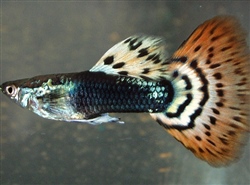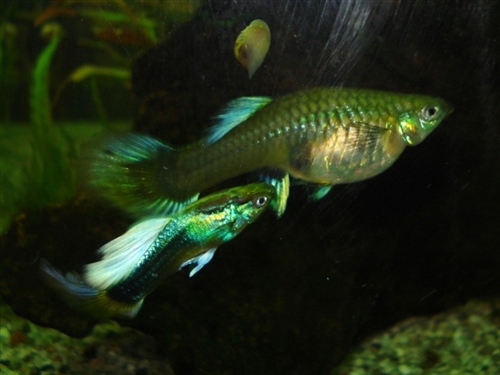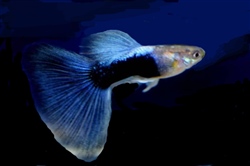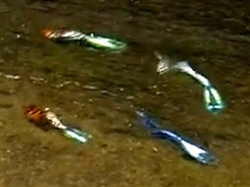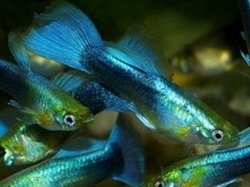Art IV
Guppy: a new vision on the Genetics of the Types (2)
RUBRIEK: Guppy Kweek English Translation
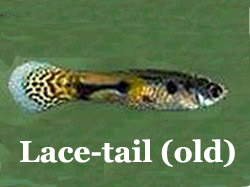
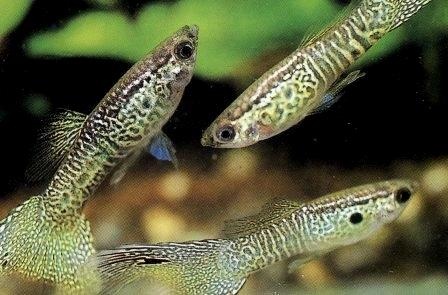


In my youth one could find beautiful solid triangles in different or mixed colors, and double swords in the aquarium shops. The first novelty of those years was the King Cobra with its Snakeskin drawing on its body and caudal fin. I was crossing with triangle tails in blue and green, but about this new strain with body markings and the color purple in the rear body, I was excited, and got to work right away . Above the hard black flame pat-tern in the caudal fin, I prefered the finer and more subtle lace drawing or filigreen (see drawing opposite).
The first observations of this filigree drawing date back to the late 1950's, when wild-caught guppies had the lace pattern on the caudal fin (see photo at the top left). These guppies were rightly called lace-tails . But it was not until 1966 that a gup strain with this mark also appeared on the body in an exhibition in Manchester. That interval of 16 years was necessary to breed the snakeskin drawing from a more chaotic pattern of stripes, spots and zigzags that already existed in the wild form. As is often the case in such matters, several breeders and authors tried to claim credit. But it often also applies in such cases, that different people in different countries (namely Germany, England and the USA) were simultaneously engaged in the same breeding project.
This is also reflected in the naming: the names Lace, Snakeskin, Cobra and King Cobra are randomly used interchangeably. Therefore, Philip Shad-dock 's suggestion to make a distinction based on the drawings is an excellent idea: Lace when the drawing consists of a network of fine dots; Snakeskin when the drawing is a bit coarser and more serpentine; cobra (sometimes also "zebra", and occasionally "tiger") when there are vertical stripes on the rear body; and King Cobra finally for Snakeskins with also more black spots on the body.
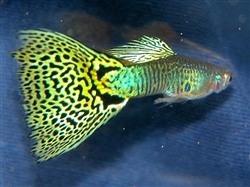


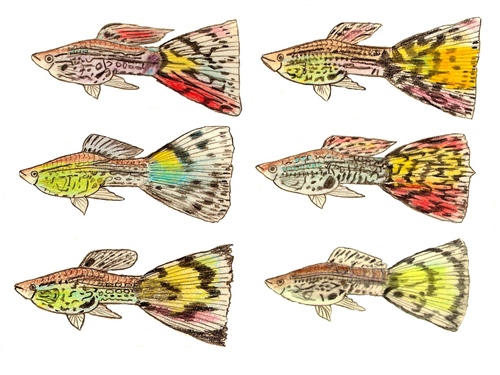
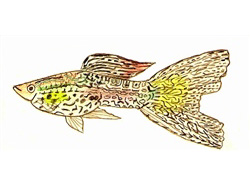
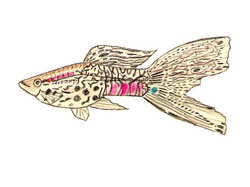

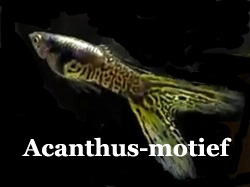
When I then mated this Snakeskin to a female from my multicolor-delta mosaic stock, I got a lot of colorful Snakeskins in the F1 generation. This meant that the Snakeskin drawing was dominant over the plainbody, even though the drawing was noticeably less pronounced and there was an ob-vious loss on it. The mosaic drawing of the caudal fin was dominant on the lace drawing, because all hybrids had that mosaic, but in different degrees and density. And finally, yellow and red also appeared to be dominant over white and blue, for all F1 males clearly displayed these colors, or at least green as a result of the overlap of yellow over blue (see drawings above). Since it is difficult to photograph a fish in an aquarium anyway, and I was not at all skilled in the fine art of photography in 75, I made drawings of my guppies at the time with a lot of patience and perseverance. And if I compare this with how others achieved it, I think I can be quite satisfied with my artworks.
Backcrossing showed males with the Snakeskin drawing on body and tail fin in the following generations, but now the tail shape was a problem in itself (see drawings above left). So there was a relapse or regression to a kind of coarse double-edged sword (with "bands"), indicating that the Snakeskin was originally bred from double-sword strains. This turned out to be the case today, and on the leftone can see a photo of such Snakeskin swords. Sometimes one has to deal with the same problem in this time with "modern" strains. There under on the left, such an example of what I think is a particularly beautifully drawn guppy.
All of this together ultimately shows how difficult it was to breed this completely new strain, and why it took so much time and patience. The Snakeskin gup is one of the few REAL and true renovation types that have been cultivated by growers all over the world over the decades. Because the majority of the so-called "modern types" simply continue to permute gene pieces between existing types, or search for the most recessive characteris-tics to the furthest corners.
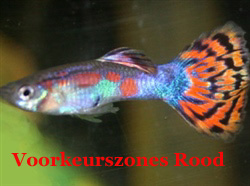
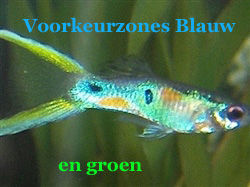
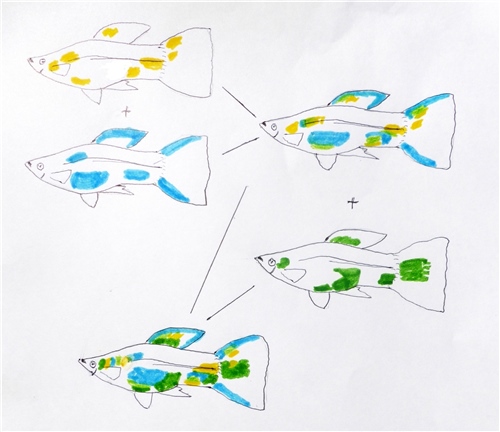
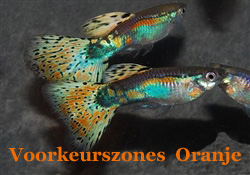
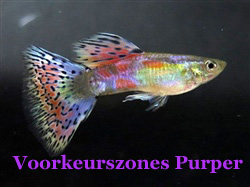
Time to take a step back by dwelling on the colors . It is well known that hard and dark colors predominate over soft and light colors. So red and black can mask other colors : blue and green can be genotypes , but nevertheless remain phenotypicly "invisible". But this is only half the sto-ry: first, colors are associated with specific preferred places or locations on the body. Of course, this problem does not arise when one breeds uni-form monochrone colored guppies: blue guppies, green guppies, yellow guppies, red guppies, purple guppies, white guppies, black guppies ......
But that is precisely so SPECIFIC and beautiful about the guppy, and that is why it owes its enormous variability in color. Breeding single-colored guppies may gain prestige as breeding performance and deserve apprecia-tion, but in reality they also always violate the guppy's multicoloreness . From this one can deduce that I personally am in favor of a harmonies interplay of colors, as it works in nature. When "the hand of the human" is TOO MUCH noticeable in the guptypes, this often results in objectively very ugly guppies. And by all means guppies may perfectly meet the stan-dard norms, but an ugly guppy is and will always be an ugly guppy. It is more pleasant to look at a beautiful gup that flares up a different color tone every time it swims, than to look at a perfect but monotonous and relati-vely boring guppy.
Second, when colors only partially fill their possible color locations and occupy only the preferred spots, they form in the overlap zones MIXED COLORS (see drawing center above). This means that the color green, for example, can occur both as an inherited green at the specific color loca-tions for green, and can arise both as a mixture of yellow and blue at the overlapping regions between both color locations. This gives a green in all kinds of shades and brightness. Now those locations for colors are of cour-se not a "must", but it can still be noted that the different colors preferen-tially appear at specific places on the body, and thus one can catalogue such preferred zones by color. The individual heritability of each guppy then determines which and how many of those spots are taken.
The average guppy breeder will take little account of this reality, except for the difficulty of obtaining a certain color in single color guppies in places that are not a preferred zone for that color. This "problem" was "solved" later in time by fixing pieces of DNA in mutations into a fixed and unalte-rable piece that is inherited (as in Japan blue, Moscow, ...). I will come back to this later, but in the meantime I will notice that I myself am going in the opposite direction: in order to preserve the color splendor of the gup and prevent unsightly hybridization, one must respect those color zones. instead of being occupied with "paste work".

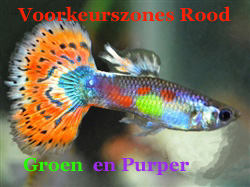
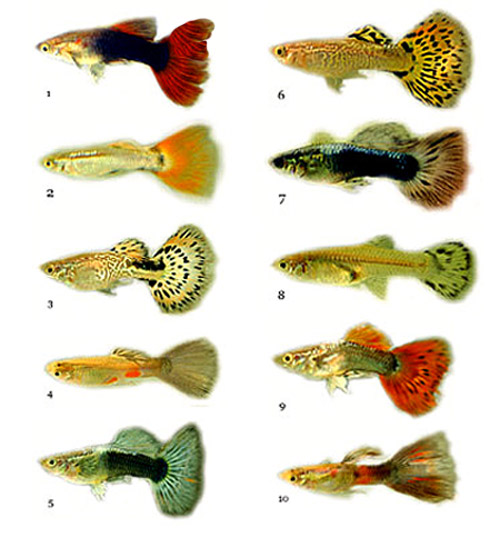
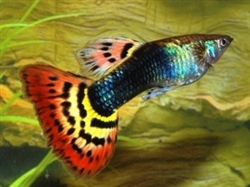

Let us go back to the thread of our guppy story through time: which types could be found in the 1970's (photo above)? One new one stands out: the half black or tuxedo . The origin of this variety is somewhat shrouded in mystery: although wild guppies show a tendency to show black spots, stri-pes and even zones on the rear body, how these individual "islands" then eventually were brought together to form one large plane zone in the rer body, still remains in the dark. With giving the first specimens afterwards the name nigrocaudatus , the riddle was of course not unveiled. The "problem" I have with this half black is that it turns out to be super-domi-nant: once it has been introduced into its breeding lines, it cannot get away from it. Nor is it linked to the sex chromosomes, as both males and females show the black rear body.
The advantage of this half black is that you can continue to cultivate it ca-refree, and that you only have to pay attention to the secondary colors of its strain: yellow, white, blue, yellow, red, green, ..... It is therefore also a very popular strain with which many enthusiasts are working. But the disad-vantage is that many of those combinations look rather flat and not very refined. I am not necessarily talking about fish with the colors of the flags of Belgium and Germany, for example, but also other color connotations that are "absorbed" by the black. Uniformity often guarantees monotony and a lack of brilliance .
The charms of the half-black lie precisely where that uniformity is broken: sparkles, islands and irises in metallic colors, which glow brightly against the black like stars in the black night sky. In particular the back stripe that illuminates fluo and the sparkles in the front body are the true beauty of this strain. And not the black, grown pectoral fins (dumbo's or big ears) or super large and super round tail fins (full moon), which unfortunately turn guppies into circus-fish and prevent their normal swimming.
